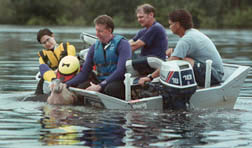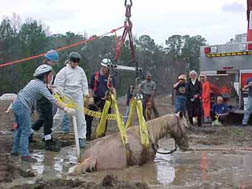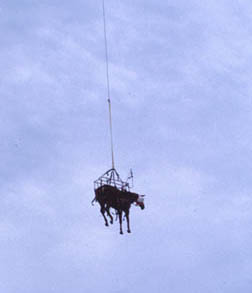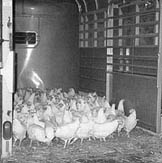by S. Cotton and T. McBride* (8/13)
Quick Facts….
- Adrenalin, panic and confusion affect both humans and animals.
- The survival instincts of livestock can make normal handling techniques ineffective.
- The accepted sequence for safety and evacuation is people first, then pets, then livestock, then property.
- The proper disaster management approach needs to vary with each type of disaster.
- Livestock management priorities during a disaster should focus on immediate safety.
Many people in the United States are moving back to rural communities. For many reasons, these new rural residents often desire a lifestyle that includes owning horses, cattle, goats, chickens, ducks, sheep, llamas, alpacas and others. As people move closer to their natural resources, they also move farther from the protection offered by urban and suburban infrastructure. It can be argued that rural living offers improved aesthetics, lower noise levels, and the feel of more “elbow room.” These characteristics come with the responsibility of handling a larger share of emergencies that are often encountered in rural areas.
In most cases, the response time and resources in rural areas are greatly reduced. Handling disasters, those catastrophic events which stretch the capacity of communities, can only be approached with preparedness, pre-planned reaction and post-event mitigation. During a disaster event, rural residents often find their personal safety a large enough challenge without the added burden of caring for livestock. This fact sheet discusses some basic realities of livestock management during disasters. Please refer to fact sheets 1.814, Caring for Livestock Before Disaster; and 1.816, Caring for Livestock After Disaster for more information on this topic.
During a Disaster

Figure 1: Rescue workers aid a cow caught in flood waters. |
A disaster is considered an incident that is beyond the scope where individual, local and community resources can deal with the event as an emergency. This usually indicates the event either happens very rapidly, there is no mitigating control, or both. This is why emergency service responders use the idiom “You respond to emergencies—you recover from a disaster.”
Normally, the response time for disaster is extremely limited. If you are not aware of pre-existing conditions, you will have even less time to respond. It’s important to develop a priority system for safety efforts. The accepted sequence for safety and evacuationb is people first, then pets, then livestock, then property. Your personal priority system may vary but you should always put the safety of people far ahead of other concerns. Understand that your desires to address pets, livestock, and property will not precede the personal safety of everyone in the disaste-raffected area.
There are differences in the speed, characteristics, risks, and response protocols for different types of disasters. Identify which disasters have a better chance of happening in your area and address those risks first.

Figure 2: Rescue workers free a horse caught in mud after a storm. |
Flash Floods
Flash floods usually occur in areas where the landscape cannot absorb all the water during excessive precipitation events, in steep gradient landscapes, or in zones that have been recently affected by drought or wildfire. Living downstream from a significant precipitation event is a danger zone. Knowing if you are actually downstream may not necessarily be apparent since many flash floods happen in arid states such as New Mexico, Arizona and Texas. Livestock have a natural move away instinct to flash flood waters. They generally seek higher ground if possible. When purchasing or designing your livestock operation, it is important to allow livestock a way to reach high ground in each pasture. Without access, livestock will fight fences and be at a greater risk of drowning. Livestock will initially panic during flash floods. This complicates livestock handling.
Large Floods

Figure 3: A horse gets airlifted during this rescue. |
Since large-scale floods are more predictable and usually slower to develop than flash floods, you may have more response time. Livestock will move gradually away from rising floodwaters to higher ground. Unfortunately, the higher ground may not be high enough to compensate for the final flood level of large-scale floods. In southeastern states, floods caused by tropical storms have actually left floating dairy cattle suspended in trees when the waters receded. If you live in large flood regions, it may be useful to invest in a good boat to help manage your livestock under disastrous conditions.
Tornadoes
Tornadoes have extreme intensity, wind speeds 2 to 3 times that of a hurricane, but they have a very short duration. Livestock hear and sense impending tornadoes. If your family or home is at risk, the livestock will be a non-issue. If your personal safety is not an issue, you may only have time to relocate your livestock. Do not cut your safety margin short since tornadoes can veer, change speed and change footprint width very quickly. Relocate your livestock, if you must, and then exit the area in a tangent direction away from the expected path of the twister.
Hurricanes
Hurricanes usually become an issue for livestock when the storm reaches landfall. Hurricanes often generate coastal flooding and are accompanied with high winds and heavy rain. Advance warning is usually available so livestock can be moved inland prior to the storm’s arrival.
Suggestions for Animal Safety
|
Blizzards
Snow blizzards can easily reach disaster status if conditions are right. Most livestock move away from the storm onslaught unless they are moving to a habitual source of shelter. Some livestock shelters (canyons, draws and windbreaks) can start out as protection in a snow storm and quickly become “drift over” hazards, so you may need to move livestock to shelter areas that have reduced risk of being buried by the drifting snow.
Travel and visibility will be difficult, especially if you do not have an appropriate vehicle. If you live in snow-prone areas, you should have access to heavy equipment and snow vehicles. If you are in a less prone area, you may only need to know resources with such vehicles.
Livestock will resist being moved from an area with limited protection and usually also resist efforts to move them into the face of a storm. For this reason, plan your management approach as early as possible. Young animals are a special risk since they can get buried in snow more easily and have less physical strength and less resistance to cold exposure. Address the young animals first and the older livestock will often follow from both maternal and herd instinct. Although animals rarely get frantic or panicky during blizzards, they do get determined to avoid the wind, cold and poor footing.
Ice Storms
Rapid onsets of freezing rain combined with the risks of blizzards increase the chances for extreme hypothermia. Move livestock promptly to shelter where feed is available. Forage is often temporarily inaccessible during and immediately after ice storms. Animal reactions to ice storms are similar to that of blizzards.

Figure 4: Hens being transported in a horse trailer. |
Wildfires
Although the surface speeds of wildfires vary from 5 to 40 miles per hour, all wildfires generate smoke, heat and sound. Livestock are very sensitive and responsive to wildfire anywhere within their sensory range. Normal reactions vary from nervousness, to panic, to aggressive and resistive escape attempts. Livestock are often injured or killed by fleeing from a wildfire into fences, barriers and other fire risks. Once the flight syndrome kicks in, it is retained long after the smoke, heat and noise stimuli are removed.
Some animal species such as alpacas, llamas and especially horses become virtually unmanageable in the face of oncoming wildfire. In situations like this, experienced handlers (as many as possible), proper equipment, and a firm and prompt evacuation approach is needed. In the case of a fast moving fire, some landowners spray paint their phone numbers on the sides of livestock or others attach identification tags to animals. If you choose to leave a halter on your animal, consider attaching identification—such as a luggage tag.
Avalanches
Sudden downslides of ice, snow and dirt are difficult to plan against. Moving livestock away from those areas when risks are present is recommended. There is seldom time for management or animal reaction during the event. If your pasture, pens or egress road are below a slope that is steep and accumulates snow, be cautious when heavy snow falls on old frozen snow and is then followed by a warm period. Classes in avalanche conditions are available in most areas.
| During several recent fires in Colorado, a media spokesperson quoted a fire boss as saying, “We need more trailers to get this livestock out of the area.” Meaning well, this information went out on television and radio. Not realizing that the fire team already had trained animal evacuation volunteers en route, area citizens reacted by hooking up their trailers and heading to the fire area. These impromptu volunteers were stopped by law enforcement because they were not part of an official animal response team. The number of volunteers was so extensive that the resulting traffic congestion prevented access to the area by not only the actual animal evacuators, but also fire trucks and medical services for an extended period of time. |
Drought
Drought is a silent disaster (along with famine and pestilence) because it has a slow onset period that does not encourage monitoring because of its discomfort. The key elements to managing animals in drought disaster are food, water and shelter. The lack of any of these factors, or a scarcity of one or more, can lead to a slow death for livestock. Animal reaction to drought is slow and vague until at critical health levels. Of all the disaster types, drought has the greatest potential to affect the widest area, often impacting multi-state regions at the same time.
Difficulties You May Experience
If you have time to address the safety of livestock, you may notice the following difficulties.
- Animal reactions when under duress. As previously mentioned, animals can be resistant in disasters that are annoying, but not frightening, such as blizzards and slow floods. During disasters that stimulate nervous reactions, such as flashflood, wildfire and tornadoes, animal owners may see a behavioral pattern from their livestock that they are both unprepared and unable to handle. This is one reason why emergency disaster management directors limit how much time owners can have to address livestock. This delay may imperil the residents and secondarily first responders. The local emergency system may have an organized predetermined group of volunteers who are trained, equipped and coordinated to move into disaster areas to deal with livestock evacuation. These County Animal Response teams (CART) likely include local stockmen associations, rodeo contractors and animal control professionals. They operate in coordination and under the direction of the disaster team. They are also trained in incident command system protocols and specific disaster risks and safety practices.
- Access and transportation difficulties. Traditionally, livestock producers have the equipment, resources, experience and practice to move livestock under a variety of conditions. Newer rural residents may lack livestock movement equipment, or enough equipment to handle their livestock population. This often stems from an operational philosophy. Producers expect the need to move large animals between forage sites and then off site to a market on a regular basis. Many new residents are only concerned about getting the livestock to the premises. Often acquisitions are made gradually and sequentially with limited equipment. The result can be a bottleneck for evacuation purposes. Animal evacuation from a disaster area must occur in a coordinated manner under the direction of the incident command team to allow success without impeding handling of the disaster and while protecting public safety.
- Equipment and facility design risks. Any livestock handler will tell you that when stress and an emergency combine while moving livestock is when you will find every hole in the fence, every sharp edge on the equipment and every loose board on the trailer.Having properly designed and effectively maintained equipment and facilities are critical during disasters. Remember, you will be handling agitated livestock with an extremely limited time frame.
- Losing focus on the disaster event. The large amounts of stimuli and tension generated during disasters affect both humans and animals. Because people get so focused on 1 to 3 objectives they often fail to look around and notice the other things that are going on around them. Emergency responders get better at avoiding this problem with experience and training. Usually they follow a response guideline that reminds them to take in all the other factors. Although it’s not desirable for livestock owners to face so many disasters that they also develop this broad focus, there is one key approach that helps enhance safety in tense situations—teamwork. Take help and designate one person to keep watching for additional oncoming hazards.
References
Disaster Preparedness Guidelines for Livestock Owners. Indiana State Public Board of Animal Health.
Disaster Preparedness Guidelines for Horse Owners. Indiana State Board of Animal Health.
Guidelines for the Development of a Local Animal Care Plan in Emergencies, Disasters, and Evacuations. Heath, Sebastian E. Ph.D. D.V.M., Purdue University, School of Veterinary Medicine.
Livestock Handling and Transport. Grandin, Temple. Ph.D., Colorado State University, 1993
Behavioral Principles of Livestock Handling. Grandin, Temple. Ph.D., Colorado State University, 1989.
Cattle Handling Safety in Working Facilities. Hubert, D.J., et al. Bulletin F-1738 Oklahoma State University Extension fact sheet.
Disaster Planning Tips for Pets, Livestock and Wildlife. Federal Emergency Management Agency publication, June 2002.
*S. Cotton, Colorado State University Extension Pueblo County range management agent and Extension Disaster Education Network (EDEN) coordinator; T. McBride, Colorado State University Adams County Extension director (emeritus), Extension livestock agent, EDEN. 1/04. Revised 8/13.
Colorado State University, U.S. Department of Agriculture and Colorado counties cooperating. Extension programs are available to all without discrimination. No endorsement of products mentioned is intended nor is criticism implied of products not mentioned.





